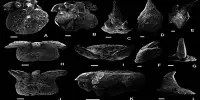Researchers from the UK and Japan have discovered that the minute flaws that reduce the effectiveness of perovskites, a less expensive alternative material for solar cells, also cause structural changes in the substance that cause degradation.
The materials also show potential for optoelectronic applications such as energy-efficient LEDs and X-ray detectors, but are constrained in their longevity. The researchers used a combination of techniques to mimic the process of aging under sunlight and observe changes in the materials at the nanoscale.
Their findings, which were published in the journal Nature, have the potential to greatly speed up the creation of durable, commercially viable perovskite photovoltaics.
Perovskites are plentiful and processed at a far lower cost than crystalline silicon. They can be made using liquid ink that is simply printed to form a thin coating of the substance.
The low longevity of the devices is a major obstacle to their commercial viability, even though the overall energy production of perovskite solar cells can frequently match or, in the case of multi-layered “tandem” devices, exceed that possible with conventional silicon photovoltaics.
The normal lifespan of a silicon solar panel, such as one you could find on the roof of a house, is 20 to 25 years without noticeably declining performance. Perovskite devices may not need to have as long of a lifetime as their silicon counterparts in order to compete in some markets because they are far more affordable to create.
However, cells will need to be in use for at least a decade or more in order to reach their full potential in achieving broad decarbonization. Manufacturers and researchers have yet to create a perovskite device with stability comparable to silicon cells.
Researchers from the Okinawa Institute of Science and Technology (OIST) in Japan and the University of Cambridge have now figured out how to address the “Achilles heel” of perovskites.
It has been very satisfying to see the approaches that we’ve developed at OIST and Cambridge over the past several years provide direct visuals of these tiny residual unwanted phases, and how they change over time. The hope remains that these techniques will continue to reveal the performance limiting aspects of photovoltaic devices, as we work towards studying operational devices.
Dr. Keshav Dani
The team was able to observe the nanoscale characteristics of these thin films and how they changed over time under solar illumination by working with the Department of Materials Science and Metallurgy in Cambridge, the electron Physical Sciences Imaging Centre (ePSIC), and the Diamond Light Source synchrotron facility.
The team’s previous research utilizing related methodologies has shed light on the flaws that result in shortcomings in the performance of perovskite photovoltaics’ so-called carrier traps.
“Illuminating the perovskite films over time, simulating the aging of solar cell devices, we find that the most interesting dynamics are occurring at these nanoscopic trap clusters,” said co-author Dr. Stuart Macpherson from Cambridge’s Cavendish Laboratory.
“We now know that the changes we see are related to photodegradation of the films. As a result, efficiency-limiting carrier traps can now be directly linked to the equally crucial issue of solar cell longevity.”
“It’s pretty exciting,” said co-author Dr. Tiarnan Doherty, from Cambridge’s Department of Chemical Engineering and Biotechnology, and Murray Edwards College, “because it suggests that if you can address the formation of these surface traps, then you will simultaneously improve performance and the stability of the devices over time.”
The researchers have demonstrated that it is feasible to control how many of these harmful phases form and, consequently, how long the device will last by adjusting the chemical composition and how the perovskite layer forms during the preparation of the devices.
“The most stable devices seem to be serendipitously lowering the density of detrimental phases through subtle compositional and structural modifications,” said Doherty. “We’re hoping that this paper reveals a more rational, targeted approach for doing this and achieving the highest performing devices operating with maximal stability.”
The team is certain that their most recent discoveries will advance the development of the first commercially viable perovskite photovoltaic devices.
“Perovskite solar cells are on the cusp of commercialisation, with the first production lines already producing modules,” said Dr. Sam Stranks from Cambridge’s Department of Chemical Engineering and Biotechnology, who led the research.
“We now understand that any residual unwanted phases even tiny nanoscale pockets remaining from the processing of the cells will be bad news for longevity of perovskite solar cells. The manufacturing processes therefore need to incorporate careful tuning of the structure and composition across large area to eliminate any trace of these unwanted phases even more careful control than is widely thought for these materials. This is a great example of fundamental science directly guiding scaled manufacturing.”
“It has been very satisfying to see the approaches that we’ve developed at OIST and Cambridge over the past several years provide direct visuals of these tiny residual unwanted phases, and how they change over time,” said co-author Dr. Keshav Dani of OIST’s Femtosecond Spectroscopy Unit. “The hope remains that these techniques will continue to reveal the performance limiting aspects of photovoltaic devices, as we work towards studying operational devices.”
“Another strength of perovskite devices is that they can be made in countries where there’s no existing infrastructure for processing monocrystalline silicon,” said Macpherson.
“Silicon solar cells are cheap in the long term but require a substantial initial capital outlay to begin processing. But for perovskites, because they can be solution processed and printed so easily, using far less material, you remove that initial cost. They offer a viable option for low- and middle-income countries looking to transition to solar energy.”















